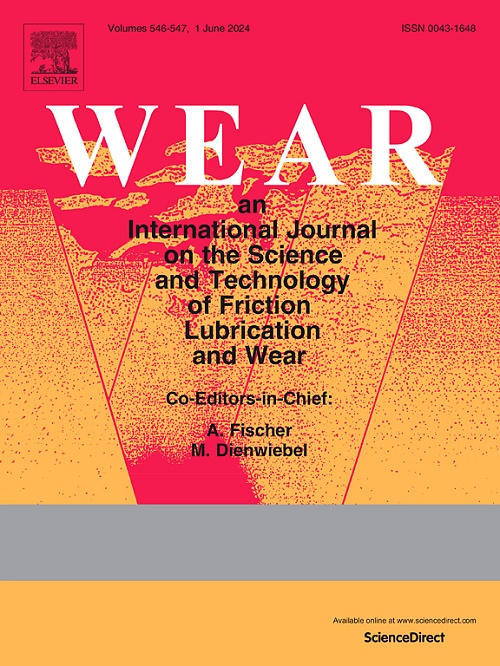Evaluating tool wear mechanisms, hole integrity and drilling performance of indexable and solid carbide tools on GFRP-Steel stacked composite
IF 5.3
1区 工程技术
Q1 ENGINEERING, MECHANICAL
引用次数: 0
Abstract
Engineers are exploring GFRP-steel hybrid materials for various applications due to their superior mechanical properties with lightweight. However, machining these materials poses significant challenges due to mismatch leading towards accelerated tool wear and compromised surface quality. Therefore, the present study reports a comprehensive analysis of drilling GFRP-steel stacked composite using indexable inserts and solid carbide drills in dry conditions. The experiments were designed by varying key process parameters such as feed rate (10–20 mm/min) and spindle speed (2400–4800 rpm). While, five significant response variables of this study were investigated as surface roughness (Ra in μm), tool wear (TW in μm), diametric error (DE in μm), delamination factor (Fd) and drilling temperature (Td in °C). Key findings revealed that indexable drill exhibited superior TW due to its robust design and efficient cutting-edge geometry, reducing localized stress and heat. TW significantly increased by increasing the feed rate and spindle speed. SEM analysis of solid carbide drills and the indexable inserts revealing grooves, adhesion, and coating delamination at higher spindle speed and feed rate, but lower for indexable inserts. Roughness analysis highlighted that indexable inserts resulted reduced Ra of 0.09 μm at 10 mm/min feed rate and 3600 rpm spindle speed compared to the solid carbide drill (Ra 1.28 μm). The indexable drill ensured better accuracy with a minimum DE of 10.33 μm compared to 42.94 μm for the solid carbide drill, attributed to enhanced chip evacuation and reduced thermal stress. Delamination control was more effective at 10 mm/min feed and 3600 rpm spindle speed, minimizing material separation, whereas higher settings (20 mm/min, 4800 rpm) amplified delamination. The indexable inserts maintained consistently lower drilling temperatures, with the solid carbide drill reaching a peak of 482 °C due to higher frictional heat generation, underscoring its superior thermal stability and wear resistance.
gfrp -钢叠层复合材料可转位和整体硬质合金刀具磨损机理、孔完整性和钻进性能评价
工程师们正在探索gfrp -钢混合材料的各种应用,因为它们具有优异的轻量化机械性能。然而,由于不匹配导致加速刀具磨损和表面质量受损,加工这些材料带来了重大挑战。因此,本研究报告了在干燥条件下使用可转位刀片和固体硬质合金钻头钻取gfrp -钢堆叠复合材料的综合分析。通过改变进给速度(10 ~ 20 mm/min)和主轴转速(2400 ~ 4800 rpm)等关键工艺参数进行实验设计。同时,研究了5个显著响应变量:表面粗糙度(Ra in μm)、刀具磨损(TW in μm)、直径误差(DE in μm)、分层因子(Fd)和钻孔温度(Td in°C)。主要研究结果表明,可转位钻头由于其坚固的设计和高效的尖端几何结构,减少了局部应力和热量,表现出了优越的TW。随着进给速度和主轴转速的增加,转速显著提高。固体硬质合金钻头和可转位刀片的SEM分析显示,在较高的主轴转速和进给速率下,有凹槽、附着和涂层分层,但可转位刀片的情况较差。粗糙度分析强调,与整体硬质合金钻头(Ra 1.28 μm)相比,在10 mm/min进给速度和3600 rpm主轴转速下,可转位刀片的Ra降低了0.09 μm。可转位钻头确保了更高的精度,最小DE为10.33 μm,而固体硬质合金钻头的DE为42.94 μm,这归功于增强的切屑清除和降低的热应力。在10毫米/分钟进给量和3600转主轴转速下,分层控制更有效,最大限度地减少了物料分离,而更高的设置(20毫米/分钟,4800转)放大了分层。可转位刀片可持续保持较低的钻进温度,由于摩擦产生的热量较高,整体硬质合金钻头的峰值温度可达482°C,这凸显了其优越的热稳定性和耐磨性。
本文章由计算机程序翻译,如有差异,请以英文原文为准。
求助全文
约1分钟内获得全文
求助全文
来源期刊

Wear
工程技术-材料科学:综合
CiteScore
8.80
自引率
8.00%
发文量
280
审稿时长
47 days
期刊介绍:
Wear journal is dedicated to the advancement of basic and applied knowledge concerning the nature of wear of materials. Broadly, topics of interest range from development of fundamental understanding of the mechanisms of wear to innovative solutions to practical engineering problems. Authors of experimental studies are expected to comment on the repeatability of the data, and whenever possible, conduct multiple measurements under similar testing conditions. Further, Wear embraces the highest standards of professional ethics, and the detection of matching content, either in written or graphical form, from other publications by the current authors or by others, may result in rejection.
 求助内容:
求助内容: 应助结果提醒方式:
应助结果提醒方式:


